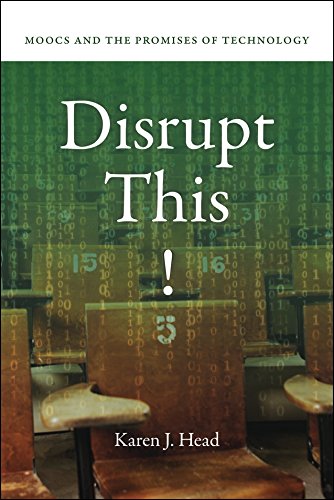You have /5 articles left.
Sign up for a free account or log in.
Don't let the subtitle of Disrupt This! -- "MOOCs and the Promises of Technology" -- fool you. Yes, massive open online courses have already come and (largely) gone as a phenomenon. So, you might ask, what can I possibly learn reading about a craze that has already been through the Gartner Hype Cycle?
Because other trends have already followed, and more are certainly to come, says the author, Karen Head, an associate professor (and incoming associate chair) at Georgia Institute of Technology's School of Literature, Media and Communication. Pick a buzzword -- personalized learning, predictive analytics, competency-based education, adaptive learning -- and you can find companies and pundits promoting it as the next big thing to transform higher education. And most of them can be summed up by the central keyword in the book's title, the idea that colleges and universities are facing a giant wave of disruption that will, depending on one's point of view, potentially save or destroy higher education.
Head, who also directs Georgia Tech's Communication Center, isn't a Luddite, and Disrupt This! is not a screed against the use of technology in the teaching and learning process. It is, however, a warning about the "near-religious faith" that some institutions have in the promise of new technologies (fueled by Silicon Valley investment and the rhetoric of some high-profile futurists) and an appeal to professors to play a more central role in when and how their institutions bring technology into the learning process.
In the exchange below, Head answered questions via email about Disrupt This! and its lessons for faculty members and administrators alike.
Q: The book is nominally about what you learned from your experiences as an early experimenter in Georgia Tech's MOOC initiative, but it is less critique of the MOOCs themselves (which you note have largely receded as the hype wore off) than of the disruptive promises and threats of technology in educational delivery generally. Is that a fair reading, and if so, what do advocates for "disruption" in higher education get most wrong and what dangers flow from those flaws? And are there insights from the disruption theorists that you believe college leaders should heed?
A: Indeed. The book is a critique of the hype and punditry, and I present a thorough account of the types of rhetorical moves that some writers use to attempt to legitimate their arguments -- moves like the incorporation of religious language. Now that the mania surrounding MOOCs has subsided, many experts have quietly moved on to other supposed disruptive technologies or business trends. It’s a bit of a fashion industry, and it’s remarkable to me that universities are vulnerable to this.
I’m not a scholar of business change, so I won’t attempt to answer the question about what insights we should heed from disruption theorists. I understand that disruptive innovation is just one of several theories, and that the evidence for it is being questioned among scholars who study business change. That’s not to say that universities are not going to change in the coming decade; they probably will, possibly dramatically. The one thing we do know with some confidence, however, is that the biggest drivers of change are unlikely to be obvious in advance. They could just as well be political or social as technological. The senior administrators I know are very smart and thoughtful people. They don’t need gurus.
Consequently, in my opinion, disruption theory isn’t at the heart of what leaders should concern themselves with. My advice would be to identify the ways to convincingly market what universities can provide for the public -- to re-engage the notion that education is a public good. If leaders do not find easy-to-understand ways to present what their universities do as special and essential, then some people will drift toward alternatives that, on the surface, seem reasonable and acceptable.
Q: What in your view are the primary reasons why many instructors are wary of the role of technology in higher education generally and, if the reasons are different, in their own classrooms? What should institutions be doing (and not doing) to overcome those objections or concerns, since no technology or innovation in higher education is going to work if those on the front lines don't buy in?
A: One story I tell at the end of the book is how, post-MOOC, I wanted a break from being involved in new technology experiments for a little while. Instead, I found myself agreeing to serve on the faculty steering committee to determine the requirements for a new learning management system. Part of that process involved me piloting one of the potential platforms. When companies know you are part of the evaluation team, the technical support you receive is extremely “high touch.” I received so much one-to-one assistance that my success using the platform was nearly guaranteed. The company was invested in my experience for obvious reasons, but I remember thinking that this was exactly the kind of experience I hoped for my students to have. I was particularly happy when I learned that the learning management system I had piloted had been chosen, and I immediately signed up to be in the first group to implement the platform -- again because I knew I would have “premium” support. If every professor experienced this kind of onboarding for a new technology, then many more professors would be less resistant to the changes associated with new technology. Professors need the time to learn about and experiment with new technologies, and they need personal support to ensure their success.
Another way to work with faculty is to bring in experienced distance-learning professionals. I’ve had the opportunity to meet some of the top practitioners and scholars in the e-learning field. Many of them developed excellent training programs, some with extraordinary “sand boxes” for trying out a variety of technological tools. These facilities are often “one-button” spaces in which a faculty need only push in a USB drive (or link to the cloud), and then press a single button to drive the entire system. Instructional designers and technologists are also key players in helping faculty acclimate to and embrace technology by diminishing the learning curve and time to use.
Q: You are dismissive at various points of the possibility that using technology to deliver instruction at scale can give professors the knowledge classroom instructors gain about their students' strengths and weaknesses, and help them tailor teaching to their needs. But you also acknowledge that you're accustomed to 30-person creative writing courses, not the 150- (or 300- or 500-) student lectures standard at many universities in many disciplines. Do you not see promise in the much-ballyhooed idea that technology can increase personalization, as defined by arming instructors with much more information about the strengths and weaknesses of individual students and adapting content, tutoring and assessment based on those analyses?
A: In many ways, this question is dependent upon what elements you include in “instruction.” If you mean the individualized delivery of general content for mastery, then I think that has proven scalable, as are many self-paced online learning aids for courses like calculus. However, the higher-touch instructional work necessary for teaching writing (or other “soft skills”), doesn’t easily scale, and the burden of proof lies with people claiming that it can.
My writing courses are capped between 16 (for creative writing) and 25 (for composition or technical writing) students. My literature courses, which are much less writing intensive, are capped at 35. Those numbers, as you note, are much lower than in some fields, but for a student to demonstrate mastery involves more personalized attention from an instructor. Even in some STEM courses, like first-year problem-based learning or studio courses, which you find in design-intensive fields like biomedical engineering and architecture, also require personalized interactions. Ultimately, the only pale imitation of personalization that's feasible in large classes is the kind that can be delegated to self-paced online learning aids, which address the lowest levels of Bloom's taxonomy -- the memorization of facts and basic principles, without the application, transfer to novel situations, integration or creativity, which are the very things that employers say they want. In fact, “adaptive” technologies essentially reimplement more flexibly B. F. Skinner’s ideas from the 1960s about programmed learning. These are personalized learning only in name. For creative, integrative learning, there are no shortcuts: it's either quality or efficiency, and there's no magic bullet.
My foremost concern with all issues of scalability is whether the economic drivers will create exigencies that lead to more “better than nothing” arguments about education in general. Could we find ourselves in a future where there are only two types of education: those who can afford an elite education get a high-touch education, and everyone else gets “something that is better than nothing” at scale? I hope not.
Essentially the problem isn’t technology, per se. Problems arise in how technology is employed. Technology does offer many affordances that instructors can use to increase the amount of high-touch instruction they provide. Hybrid/flipped classrooms have demonstrated this, and I am an advocate of using technology as one pedagogical tool among many. Data can also alert instructors to certain trends, but some students often present as struggling much sooner, if the professor is interacting with them. Algorithms can’t see a student who clearly hasn’t slept in days, isn’t eating well, is impatiently pacing outside your office or, in the worst cases, begins to cry. In fact, I have often marveled at the ability of some students to continue to complete assignments with success while enduring a crisis, but this doesn’t mean they are being as successful as they might be if the problem is identified sooner.
Q: Some might read Disrupt This! as a caution (if not a call to arms) against the use of technology in the classroom. Instead, you seem to accept that technology-infused teaching is going to be part of the fabric of higher education going forward, and to believe that professors should be more engaged, not less, in understanding the technology, gauging its effectiveness and playing an active role in deciding when, how and which kinds of technologies are used. What role should professors be playing on their own campuses -- and in the national dialogue, to the extent they choose to be involved in that -- around instructional technology?
A: I’m a big believer in getting your hands dirty. You need to earn a place in the conversation, and that means being part of the process. Pedagogical technology has been a fixture for decades, with learning management systems like Canvas and Blackboard ever present. Faculty cannot reasonably say that technology plays no role in their teaching, and they should not leave decisions about pedagogical technologies to others. As I say in the book,
When offers like [being part of the selection process for a new learning management system] are made to us faculty members to participate in the creation of our work environment, we should rise to the challenge. Our technology environment should not be something to complain about like the weather; we should play a role in changing it. If, as future users, we refuse to engage with administrators who may not understand the full slate of requirements in practical terms, then decisions are likely to be guided by the bells and whistles that are promoted by the manufacturer as the most innovative features available -- even if those features won’t work or aren’t really needed.
Therefore, I think administrators have to be sure evaluation committees are populated with a variety of people -- not just the true believers who clearly love technology and are comfortable using it. Another essential constituency is student representation -- again, a group with a wide range of capabilities. Skeptics, nonusers, and end users can provide much needed insight about how a new technology might (or might not) become an integrated and productive tool. The same diversity for assessment committees is also crucial. Administrators also have to demonstrate that they are listening closely to the needs expressed by faculty and students -- resisting any “sexy” sales pitches by potential providers.
It is probably safe to say that any single technology will not be embraced by 100 percent of those who are expected to use it, but whatever technology is chosen should answer to as many needs articulated by the end users as possible.
Q: You make it sound like you decided to participate in the MOOC experiment at Georgia Tech over your better judgment, and your experiences were decidedly mixed. Are you glad you did? Are there ways in which it made you better at your job or a more informed citizen of your institution and higher education? What do you say to other faculty members who might find themselves in a similar position -- and to the administrators who want them involved?
A: Yes, I was hesitant to take part in the MOOC project, but that had nothing to do with the technology aspects. I’m actually a technology geek -- very often a first adopter. In this case, as a junior professor without tenure, I was concerned that an experiment focused on teaching, even one assessing a potentially cutting-edge technology, could be detrimental to my career. My institution says it takes pride in promoting innovation and risk taking, but it is not common here or elsewhere for faculty to succeed if they concentrate too much on teaching and not enough on research.
My case was unusual, because I could build a solid bridge between the two, but if a junior faculty member cannot clearly connect a teaching experiment to the research their colleagues expect from them, and get assurances that such connections will be valued, that is a risk not worth taking. I took that risk, but I would only recommend this path to others if administrators’ assurances were backed by changes in policy, and they must remove the barriers that -- despite what they may sincerely believe -- actually de-incentivize innovation.









